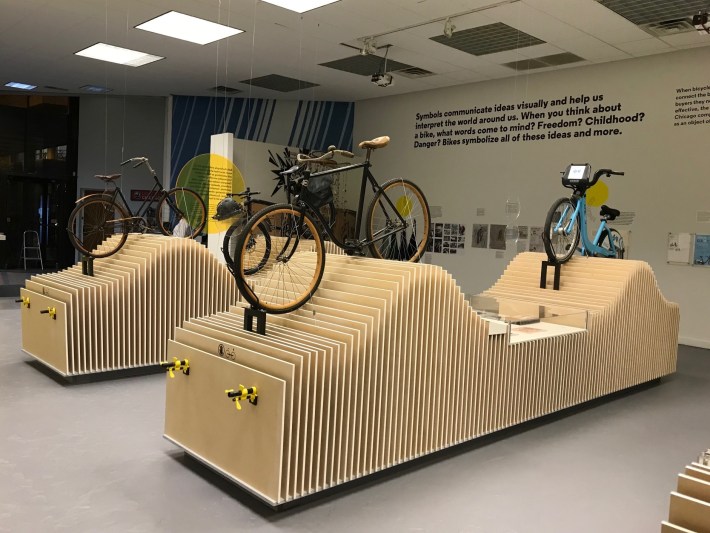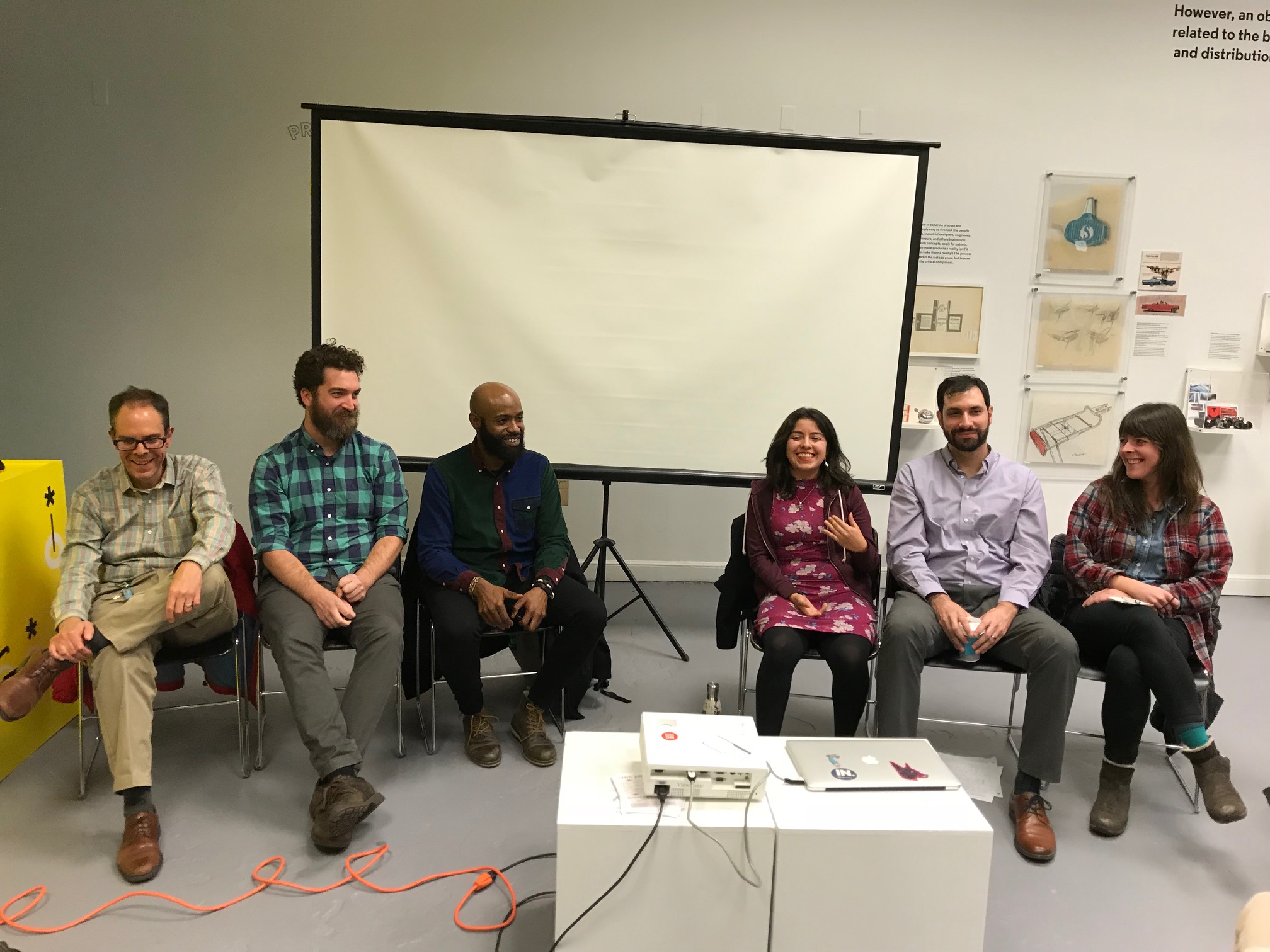During yesterday's panel discussion "Bikes, Modernity, and the Urban Landscape" at the Design Museum of Chicago's new exhibit on local bike culture, one topic kept coming up over and over. With fewer than two percent of trips to work made by bike in Chicago, transportation cycling is still a fairly niche activity here. So what needs to change to make this efficient, healthy, economical, green, and fun transportation mode appeal to a broader demographic?
Tackling the issue was a who's who of local bike leaders, including Chicago Department of Transportation staffers Sean Wiedel and Dave Smith, Active Transportation Alliance rep Jim Merrell, Blackstone Bicycle Works' Damien Lee, Jana Kinsman from the bike-powered beekeeping project Bike a Bee, and Streetsblog reporter Lynda Lopez.
Smith, a traffic engineer who designs bikeways for CDOT, began the discussion by outlining the department's goal of creating a cohesive, low-stress system of bike routes. "We want to see the bicycle network grow in a way that is really comfortable for people of all ages and abilities," including families with young children, and people who haven't ridden a bike for decades, he said. Smith noted that the city is currently focused on filling in the gaps in the current cycling network, and upgrading existing bike lanes with striped buffers and concrete protection.
Smith noted that the city installed nine miles of "neighborhood greenway" side street bike routes this years, which brings Chicago's total neighborhood greenway mileage to 11 miles. He added that while in the past it has been common for CDOT to install bikeways in a piecemeal fashion wherever opportunities arise, such as street repaving project, the department is currently trying a more holistic approach, adding multiple bikeways in an area to create "miniature bike networks." This approach was recently piloted in the Edgewater community.
Wiedel, an assistant CDOT commissioner who oversees the Divvy program and several other bike-related initiatives, said that bike-share has helped to make transportation cycling more mainstream here. He noted that over 17 million trips have been taken on Divvy to date, the system has about 37,000 regular annual members, and nearly 5,000 lower-income people have signed up for discounted Divvy for Everyone memberships. Wiedel also noted that the city has been been piloting dockless bike-share on the Far South Side since May. The test ended this month and CDOT is currently asking people who used the system to provide feedback via an online survey.
For Kinsman, who grew up in the western suburbs next to the Prairie Path, cycling has been a way of life ever since she could remember, so connecting her interest in urban farming with biking was a natural fit. Bike a Bee tends beehives around the city, transporting the materials on two wheels, and Kinsman says that being on a bike instead of inside a motor vehicle helps her make connections with locals. "People notice you and they wave to you," she said. "It's just this much more freeform exchange." She added that, as a white person traveling through communities of color for work, she finds that this accessibility is "a great way to start a conversation across the barriers that we have in Chicago."
On the other hand, Kinsman recently bought a car, and it opened her eyes to how much Chicago's built environment is still largely designed for the safety and convenience of motorists, to the detriment of everyone else. "When I'm driving my car, I don't have to think sometimes," she said. "Everything is made for you to be safe. But when you're on a bike, you're constantly on guard."

Lopez agreed, although she said she often enjoys the "puzzle" of navigating the city on two wheels "when I'm not feeling endangered." Unlike Kinsman, transportation cycling was a skill she learned as an adult. After graduating from high school she became frustrated by the surprisingly time-consuming bus commute from her home in Hermosa to a job in Logan Square, she dusted off a mountain bike in her family's basement and tried bike commuting. First she creeped along on the sidewalk, but eventually she got the knack of getting around safely and efficiently on the streets.
When Lopez attended college at the University of Chicago in Hyde Park, biking further expanded her access to the rest of the city. "It became a really practical thing for me, but also a joyful activity," she said. "I'm really interested in the intersection of joy and mobility, and how that's tied to social justice."
The more Lopez biked, the more she noticed discrepancies in who was riding, and what kind of conditions they were dealing with. "I noticed that bike infrastructure was missing in some neighborhoods like West Humboldt Park," she said. She also found that as a Latinx woman who bike commuted, she was something of an oddity in her circle of friends, and she didn't fit the stereotype of the typical Chicago cycling enthusiast.
Lopez also found that many of the people who rode bikes in neighborhoods of color didn't fit that mold either. They were blue-collar folks, often older men on inexpensive bikes riding on the sidewalk, because it was a practical way to get around, not a lifestyle choice. "So I think that's a really interesting dynamic -- who are the outliers in bicycle culture -- which I want to explore further," she said. "How do we bring biking to more people and how do we make them feel involved in the conversation?... I think it's really important to amplify more voices in biking."
Merrell, advocacy director for Active Trans, similarly emphasized the potential for cycling and other strategies for increasing mobility to improve the lives of people in historically underserved communities. He noted that one out of ten Cook County residents lives in a transit desert, with no convenient options to access job and educational opportunities without driving. "Active Trans is really interested in creating a powerful movement... to create better mobility options for everyone in the city of Chicago and address a lot of the inequality that's present in our transportation system," he said.
Lee, program director for Blackstone Bikes, a Woodlawn-based bike-education center, is living proof of the potential of bicycles to empower residents. He grew up in Altgeld Gardens, a Far South Side community that's geographically isolated from the rest of the city. But after his mother bought him a bike for Christmas, he and his friends found that they could travel to other parts of the city and suburbs that weren't practical to access on foot. "This bicycle was a form of liberty," he said. "Cycling was a transformative experience for me." He said he was fortunate to find a job that combines his love of biking with his desire to improve the lives of young people in Chicago's Black community.
However, like Lopez, Lee said, "I don't see a lot of people who look like me" on bikes in Chicago. He noted that several South Side groups have been working to diversify local cycling, from the road riding enthusiasts of the Major Taylor Cycling Club of Chicago, to the underground, POC-focused bike collective 2-Wheeled Gods. But he added that the Chicago Police Department's admitted practice of writing high numbers of tickets for bike infractions in communities of color as a strategy to conduct searches is counterproductive of that goal.
Ultimately, if we want to improve the lives of more Chicagoans through bicycling, Lee said, we need make sure that folks who haven't always been included in urban planning conversations are empowered to get involved. "We need to upstream that dialogue and make sure we're investing our money in the right places," he said.
![]()
Did you appreciate this post? Consider making a donation through our PublicGood site.




